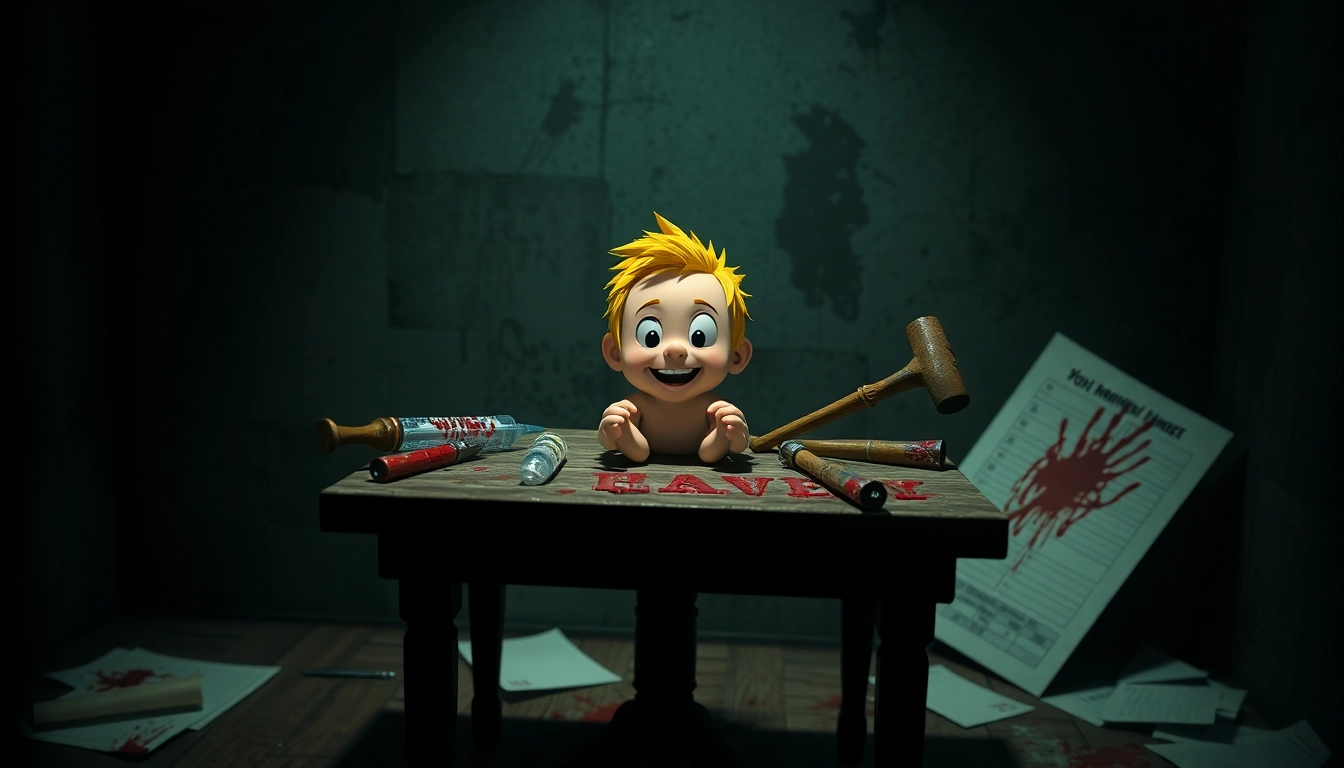Overview and Context: BloodMoney—A Dark Clicker Descent into Morality
In the realm of psychological horror gaming, few titles manage to evoke such visceral reactions and moral introspection as blood money. This unsettling game offers players a disturbing journey into the depths of human morality, wrapped in a dark clicker mechanic that forces continuous engagement with its morally ambiguous narrative. Unlike traditional horror games that rely on jump scares or gore, BloodMoney emphasizes psychological torment, moral dilemmas, and the unsettling transformation of its protagonist, Harvey, as each click pushes him—and the player—further into a state of moral decay. Its unique blend of gameplay, storytelling, and visual design makes it a profound exploration of human nature when faced with life-threatening desperation.
The Narrative: Desperation, Morality, and Survival
At the core of BloodMoney lies a compelling and harrowing story: you are someone diagnosed with a severe, life-threatening condition. The clock is ticking, and with a medical bill of $25,000 looming over your head, your options seem limited. Enter Harvey—a cheerful, seemingly innocent character who offers an unorthodox solution: click on him to generate money. This simple premise quickly spirals into a dark exploration of morality, as each click not only earns you vital funds but also inflicts pain and suffering upon Harvey. The narrative cleverly blurs the lines between innocence and cruelty, forcing players to confront what they are willing to sacrifice for survival. The game masterfully portrays the emotional toll of these choices, emphasizing that every decision bears consequences—both seen and unseen.
Game Mechanics: Clicking, Upgrades, and Visual Decay
Clicking as a Means of Profit and Morality Testing
BloodMoney’s core mechanic revolves around clicking on Harvey, which generates a dollar amount incrementally. Initially, each click feels harmless, almost playful, as Harvey’s cheerful demeanor contrasts with the grim stakes. However, as the game progresses, each click becomes increasingly visceral and disturbing. The visuals deteriorate, Harvey’s expressions shift from cheerful to pained, and the environment around him darkens to reflect the moral cost of each action. The game cleverly uses this visual decay to symbolize Harvey’s suffering and the moral erosion of the player.
Upgrade System: From Pillows to Hammers
The shop system introduces a series of upgrades that dramatically increase earnings per click. Early options include innocuous items like pillows for pillow fights, but as your desperation grows, the shop offers more violent tools: needles, knives, hammers, and even more grotesque implements. Each purchase not only boosts profits but also deepens Harvey’s pain, creating a risk-reward dynamic that is as psychologically unsettling as it is mechanically addictive. The choices in upgrades shape your gameplay style—whether to minimize Harvey’s suffering or maximize efficiency at any moral cost.
The Dark Narrative of BloodMoney: Exploring the Morality of Profit
Multiple Pathways and Outcomes
BloodMoney features three distinct pathways—each leading to different endings—reflecting the player’s moral choices. The paths are not merely about reaching a financial goal but about how you choose to do so. The Good Ending involves minimal harm, where you carefully select upgrades that cause the least pain, preserving Harvey’s dignity. The Normal Ending balances profit with moderate suffering, employing tools like scissors or the needle. The Bad Ending involves ruthless maximization of profit, using violent tools like hammers or knives, regardless of Harvey’s torment. These endings serve as a mirror to the player’s moral compass, illustrating how choices in extreme circumstances reveal deeper facets of human nature.
The Psychological Horror of Time Pressure and Moral Decay
Time becomes an oppressive force in BloodMoney. The ticking clock to reach $25,000 adds urgency, forcing players into morally compromising decisions under pressure. Harvey’s reactions—his expressions and dialogue—serve as subtle cues to the player’s impact, becoming more distressed as choices lean toward violence. The game’s pacing ensures that players feel the weight of each click, each upgrade, and each moral compromise, creating a potent atmosphere of psychological horror that lingers long after the game ends.
The Dark Narrative of BloodMoney: The Psychological Impact and Visual Evolution
Creating Unease Through Visual and Dialogue Cues
BloodMoney’s visual design plays a crucial role in immersing players in its unsettling atmosphere. Initially, Harvey is cheerful and bright, offering a stark contrast to the dark themes. As the player continues to click and purchase upgrades, visual cues such as Harvey’s increasingly pained expressions, his trembling voice, and the darkening environment evoke a deep sense of unease. Subtle details, like Harvey’s surprise at violent tools like hammers, suggest he might not fully understand what’s in the shop, adding an extra layer of moral complexity. This uncertainty amplifies the emotional impact, making players question not only their choices but also the nature of innocence and exploitation within the game’s narrative.
Visual Decay and Psychological Deterioration
The game employs a gradual visual decay—Harvey’s appearance becomes more distorted, and the surroundings darker—symbolizing the moral and psychological toll of relentless clicking. Each upgrade, especially the violent ones, correlates with more disturbing visuals. For example, using the hammer causes Harvey to grimace in agony, with blood splatters subtly appearing in the background. These visual cues serve as a visceral reminder of the human cost behind each dollar earned, pushing players to confront their own morality as they navigate the game’s unsettling landscape.
Multiple Endings: How Player Choices Define Harvey’s Fate
Reaching the Financial Goal
The culmination of BloodMoney’s gameplay hinges on whether the player can reach the $25,000 target before time runs out. Achieving this goal involves strategic choices—whether to use more violent tools or to opt for less harmful options. The game’s design ensures that even with the same endpoint, the journey—and moral implications—differ significantly based on the player’s approach.
The Good Ending: Compassion Over Profit
In the Good Ending, players limit Harvey’s suffering by opting for less violent upgrades, such as pillows or scissors. Harvey’s reactions remain relatively mild, and the visual decay is minimal. This path emphasizes compassion and moral integrity, providing a sense of redemption and highlighting that even in dire circumstances, kindness can prevail. The final scenes depict Harvey’s relief and gratitude, leaving players with a haunting reminder of the power of mercy.
The Normal Ending: Balanced Morality
The Normal Ending strikes a middle ground, employing moderate violence like needles or small blades. Harvey’s suffering is noticeable but not overwhelming. The visuals show signs of distress, but Harvey retains some semblance of his cheerful demeanor. This ending suggests that balancing profit and morality is possible but comes at a cost—a reflection of real-world compromises in desperate times.
The Bad Ending: Moral Collapse and Ruthlessness
The Bad Ending is achieved by using the most violent tools—hammers and knives—maximizing Harvey’s pain. Harvey’s appearance is grotesque, eyes bloodshot, and he reacts with screams or silence, depending on the upgrade choices. The environment is dark and chaotic, emphasizing the moral abyss into which the player has descended. This path questions whether survival justifies moral destruction, leaving a haunting conclusion about human depravity when pushed to the limit.
Community Insights and Player Reactions
Players worldwide have shared their experiences with BloodMoney, revealing deep emotional reactions and varied interpretations. Many describe feeling genuine guilt and discomfort, even when consciously choosing the less violent options, due to the game’s masterful emotional design. Forums and community videos highlight how the game challenges perceptions of morality, humanizes Harvey, and prompts players to reflect on their own values. Several players have noted that Harvey’s reactions and subtle visual cues evoke empathy, making the moral choices even more impactful. The game’s community often discusses the surprising depth hidden behind its simple clicker mechanics, with many considering it more a psychological experiment than a typical game.
The Deeper Message: Humanity’s Duality in Crisis
BloodMoney is more than a dark clicker game; it’s a mirror held up to society. It questions whether people are inherently good or evil when faced with extreme adversity. Harvey’s innocence and the dark shop symbolize the duality of human nature—the moral struggle between compassion and self-interest. The game suggests that in desperate circumstances, everyone has the potential for both kindness and cruelty. It invites players to reflect on their own boundaries and moral limits, provoking uncomfortable yet necessary conversations about survival, ethics, and the human condition.
Comparing BloodMoney to Other Psychological Horror Games
While many horror games rely on external scares, BloodMoney stands out by internalizing fear and morality. Its focus on psychological torment, visual decay, and moral dilemmas aligns it with games like Silent Hill and Alan Wake but with a unique twist: it employs a simple clicker mechanic to explore profound ethical questions. Unlike traditional horror, which often emphasizes external threats, BloodMoney’s threats are internal—moral decay and emotional suffering. Its minimalist approach makes the experience more personal and intense, positioning it as a compelling example of how gameplay mechanics can serve narrative and emotional depth.
Final Thoughts: When Morality Becomes a Game
BloodMoney is a groundbreaking psychological horror experience that challenges players to confront their own morals in a brutal, immersive environment. Its innovative use of a clicker mechanic to explore complex themes of survival, morality, and human duality sets it apart from typical horror titles. The game’s visual and narrative design create a haunting atmosphere, forcing players to ask themselves: How far are you willing to go when your life depends on it? Can compassion survive in the face of desperation? The choices you make not only determine Harvey’s fate but also reflect on the darker aspects of human nature. For those seeking an emotionally charged, morally complex game, BloodMoney offers a disturbing yet thought-provoking journey into the heart of darkness.
Related Games and Connecting with the Community
BloodMoney belongs to a niche of psychological horror titles that push the boundaries of storytelling and gameplay. Its themes resonate with other dark narrative games, but its unique approach makes it a standout. If you’re intrigued by BloodMoney, exploring similar titles like Don’t Forget or other indie horror experiments can deepen your understanding of how games can serve as mirrors to our inner selves. Connecting with the BloodMoney community—via forums, gameplay videos, and discussion groups—can enrich your experience and offer new perspectives on its moral questions. Sharing your playthroughs and insights helps foster a deeper appreciation for the complexities of human morality in gaming.
About BLOODMONEY
BloodMoney is a psychological horror clicker game that dares players to explore the limits of their morality through relentless clicking, visual decay, and moral choices. As you navigate Harvey’s suffering and your own desperation, the game reveals the duality of human nature when faced with life-or-death situations. Its powerful narrative, combined with innovative gameplay mechanics, makes it a profound experience that transcends typical horror conventions. Whether you aim for the compassionate route or embrace ruthless efficiency, each decision leaves a lasting impact—highlighting that in the game of survival, morality is often the first casualty.
Connect With Us
We hope you found this in-depth exploration of BloodMoney insightful and compelling. If you’re eager to discuss the game or share your experiences, join our community. Follow our updates for more analyses of psychological horror titles and indie games that challenge the boundaries of storytelling. Remember, in BloodMoney, every click counts—both in-game and in reflecting on the darker aspects of human nature. Stay tuned for more unsettling journeys and thought-provoking content.
© 2024 BLOODMONEY. This page is a fan-made educational resource based on the original game by SHROOMYCHRIST. Dive into the darkness, ask hard questions, and consider what truly matters when survival is on the line—because sometimes, morality itself is the greatest risk.

